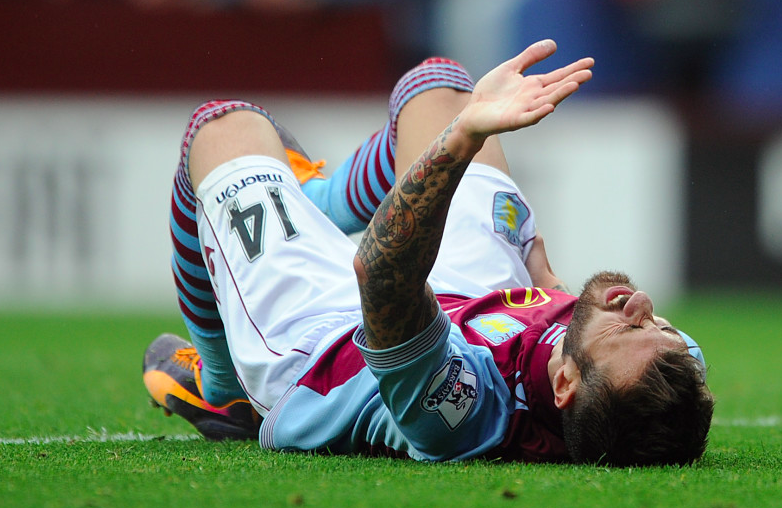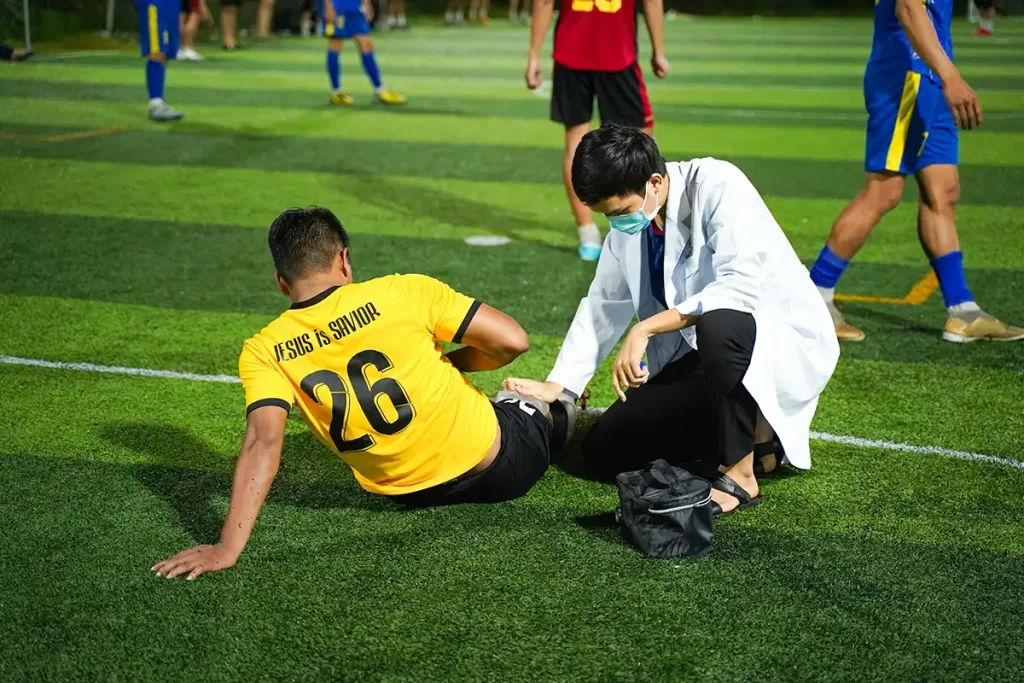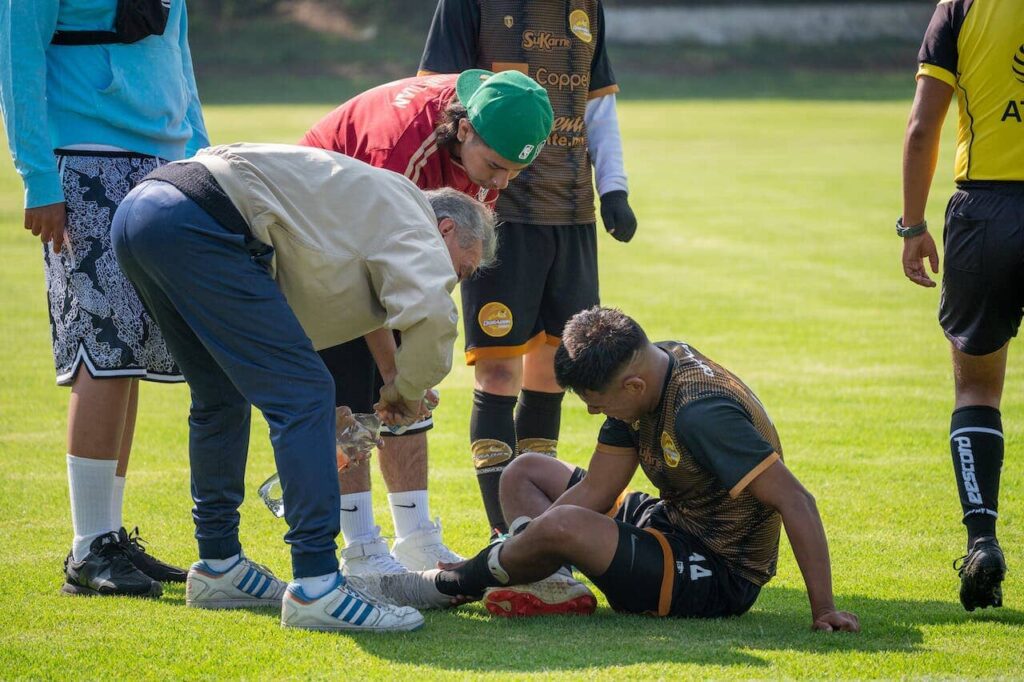How To Prevent Soccer Injuries – Complete Guide (2025)
If you are looking for information on how to prevent soccer injuries – this is for you.
Today I want to talk to you about something crucial: preventing soccer injuries.
As passionate athletes, we all know that staying injury-free is essential for reaching our full potential on the field. By following some simple tips and techniques, you can minimize the risk of injuries and unlock your true soccer potential, but ensuring you stay on the field.
So let’s dive in and discover how to prevent common soccer injuries and keep ourselves in top form for as long as possible.

How To Prevent Soccer Injuries
In this article, you can read through all 5 sections or skip ahead to the topics that are most important to you. Make sure to watch the video tutorial to get the best results. And stick around until the end for a special free gift that is guaranteed to make you a better player.
- What are the most common soccer injuries?
- How to prevent muscle injuries?
- Exercises to prevent injuries in soccer
- Bets Soccer Warm Up Ever (prepare and avoid injury)
- How to take action, keep moving forward, and improve faster than most players!
I hope this article answers all your soccer specific questions. Let’s go!

Most Common Soccer Injuries
Understanding the Most Common Soccer Injuries and How to Prevent Them:
In the game of soccer, some injuries are unfortunately more prevalent than others. But fear not, my friends, for I have gathered valuable insights to help you protect yourself.
Here are some of the most common soccer injuries and practical ways to prevent them:
a) Hamstring Injuries: Hamstring strains can be a real pain, but with proper care, you can avoid them. To prevent hamstring injuries, focus on dynamic warm-up exercises that include leg swings, lunges, and gentle stretches. Strengthening your hamstrings through targeted exercises like Romanian deadlifts and hamstring curls will also fortify these muscles, reducing the risk of strains.
b) Knee Injuries: Our knees endure significant stress during soccer, making them susceptible to injuries like sprains and ligament tears. Protect your knees by wearing supportive knee braces or sleeves. Additionally, maintaining strong quadriceps and hamstrings through exercises such as squats, lunges, and leg presses will provide extra stability and protect your knees from harm.
c) Ankle Injuries: Ankle sprains are a common hazard on the soccer field, but we can minimize their occurrence. Wearing proper ankle braces or high-quality soccer cleats with ankle support is a smart preventive measure. Regular balance and stability exercises, such as single-leg stands and ankle circles, will enhance your ankle strength and proprioception, reducing the likelihood of ankle injuries.

How To Prevent Muscle Injuries In Soccer
Understanding ways to prevent muscle injuries in soccer. Muscle injuries can be frustrating setbacks, but by incorporating these preventive measures into your routine, you can keep them at bay:
a) Warm-up adequately before every training session and game. Include dynamic movements like jogging, high knees, and lateral lunges to increase blood flow and prepare your muscles for the demands ahead.
b) Focus on building overall body strength and flexibility. Engage in strength training exercises like squats, lunges, planks, and resistance band exercises. Don’t forget to stretch regularly to maintain optimal muscle length and prevent imbalances.
c) Listen to your body and avoid overtraining. Allow for sufficient rest and recovery between intense training sessions to give your muscles time to repair and rebuild.

Best Exercises To Prevent Injuries In Soccer
It’s your responsibility to take care of your body and make it resistant to soccer injuries. Here are some specific exercises that can help you prevent injuries and boost your performance on the soccer field:
a) Dynamic leg swings: Stand facing a wall and swing one leg forward and backward in a controlled manner. Repeat with the other leg. This exercise improves hip mobility and prepares your legs for the movements involved in soccer.
b) Glute bridges: Lie on your back with your knees bent and feet flat on the ground. Lift your hips off the floor, squeezing your glutes. This exercise strengthens your glute muscles, providing stability and reducing the risk of various lower-body injuries.
c) Lateral lunges: Step to the side, lowering your body into a lunge position, keeping your knee aligned with your toes. Return to the starting position and repeat on the other side. Lateral lunges improve hip mobility and help prevent groin strains.

Soccer Injuries and How To Prevent Them
In soccer, injuries can be detrimental to a player’s performance and long-term development, often leading to extended time off the field and hindering progress.
The importance of injury prevention cannot be overstated, and one of the most effective ways to protect your body is by incorporating a proper warm-up routine before every practice and game.
Warming up prepares muscles, joints, and tendons for the physical demands of the sport, improving flexibility, circulation, and neuromuscular readiness. Despite this, many players neglect warming up or treat it as an unnecessary task, believing that they can just jump into action.
This disregard often leads to strains, sprains, or more serious injuries like ligament tears and muscle strains. By taking the warm-up seriously—focusing on dynamic stretches, mobility exercises, and light cardio—players can reduce their risk of injury.
Additionally, paying attention to rest, recovery, and listening to your body’s signals can further prevent overuse injuries. Developing a mentality that injury prevention is as critical as skill training is a key step in a soccer player’s overall longevity and success.
7 Steps To Your Best Soccer Warm Up
Soccer Injuries
Soccer injuries can be discouraging, but with the right mindset and preventive measures, you can reduce the likelihood of their occurrence.
By implementing the tips I’ve shared today, you’ll build a solid foundation of injury prevention, enabling you to fully enjoy the beautiful game and reach new heights in your soccer journey.
Remember, taking care of your body is just as important as honing your skills. Stay safe, stay motivated, and keep progressing on your path to soccer greatness!
You are capable of achieving remarkable things on the soccer field.
Train hard, stay focused, and never stop believing in yourself. The power to prevent soccer injuries and become a better soccer player lies within you. Let’s make it happen!

Common Questions
Here are some common questions related to how to prevent soccer injuries:
How to prevent knee injuries in soccer?
Knee injuries in soccer are common due to the intense demands placed on the body during rapid changes in direction, sudden stopping, and jumping. To prevent knee injuries, focusing on strengthening the muscles around the knee, like the quadriceps and hamstrings, is essential. Incorporating balance and stability exercises will help improve knee control during quick movements. Proper technique in landing from jumps and decelerating after high-speed runs can reduce the strain on the knees. It’s also important to wear soccer shoes with adequate support and ensure the playing surface is safe and even.
How to prevent hamstring injuries in soccer?
Hamstring injuries are particularly frequent in soccer due to explosive sprinting and sudden stops. Preventing these injuries involves strengthening the hamstrings and surrounding muscles like the glutes, quadriceps, and calves. Stretching before and after games helps maintain flexibility, while dynamic warm-ups like leg swings and high knees engage the hamstrings and improve their readiness. Proper recovery and rest are critical, and players should listen to their bodies, avoiding training or playing when fatigued.
How to prevent ankle injuries in soccer?
To prevent ankle injuries, it’s important to strengthen the muscles in and around the ankle, including those in the lower legs and feet. Balance exercises like single-leg stands on unstable surfaces can also help increase stability. Wearing proper footwear with ankle support can further protect against twists or sprains. Adequate warm-up routines involving lateral movements, as well as paying attention to body mechanics, can reduce the chance of injury. Moreover, wearing ankle braces or taping may provide added protection for players with a history of ankle injuries.
How to prevent ACL injuries in soccer?
Anterior cruciate ligament (ACL) injuries are often the result of sudden directional changes, poor landing technique, or excessive strain on the knee joint. To prevent ACL injuries, strengthening the quadriceps and hamstrings is crucial, as these muscles help protect the knee during rapid deceleration and pivoting. Focused drills that improve agility, balance, and neuromuscular control can be beneficial. Also, athletes should learn proper landing mechanics to avoid overstretching the knee. A comprehensive conditioning program and using the correct footwear are important for reducing the risk of ACL injuries.
How to prevent head injuries in soccer?
Head injuries, such as concussions, are a concern in soccer, especially during aerial duels or collisions. To reduce the risk, players should avoid dangerous header techniques and focus on proper heading technique and timing. Wearing protective gear, like padded headbands, may offer extra protection. Ensuring that all players understand the importance of fair play and the dangers of aggressive tackling is key. Coaches should promote good habits in training, such as focusing on proper body positioning and maintaining awareness of opponents’ movements to reduce the likelihood of impact.
Why do I keep getting injured in soccer?
Recurrent injuries in soccer can often be attributed to factors like poor conditioning, lack of proper recovery, inadequate warm-ups, improper technique, or overuse. It’s important to address imbalances in your strength and flexibility, particularly in muscles that are critical for soccer movements. Overtraining without proper rest can also lead to fatigue, making the body more prone to injury. Working with a coach or physical therapist to correct form or identify weaknesses in your game can help prevent future injuries. Consistently focusing on strength training, flexibility, and proper warm-ups will ultimately reduce your risk of injury.
What soccer position is most likely to get injured?
Certain soccer positions can be more prone to injuries due to the demands of the role. For example, defenders often face hard tackles, aerial duels, and collisions, making them susceptible to knee, ankle, and head injuries. Goalkeepers may be at a higher risk of shoulder, hand, or wrist injuries due to diving and blocking shots. Midfielders, with their constant running and turning, are prone to hamstring or groin injuries, while forwards tend to experience muscle strains or ankle injuries due to the explosive sprinting and quick cuts required. Ultimately, players in all positions need to focus on injury prevention specific to the demands of their role.

SOCCER PLAYERS
Want to become a better soccer player?
Watch this 3-minute video about discovering your true potential
Learn how to improve your skills, mindset, soccer IQ, and fitness—no matter your level. Start playing with confidence, earning respect, and impressing coaches today.
About Coach Dylan
I used to struggle with confidence in soccer, feeling slow, weak, and unmotivated. Coaches overlooked me, and friends made fun of my skills. At one point, I even quit.
But I decided to take control of my development. Through hard work, I transformed my game, earned league titles, awards, a college scholarship, and international caps.
Now, I share my lessons and help others improve through my YouTube channel (1/2 million subscribers), soccer coaching and personal training.

How To Play Soccer Better
Struggling to make progress in soccer or stay organized with your training?
The Soccer Success Planner will help you stay focused, motivated, and increase your chances of achieving your goals in soccer.
Success doesn’t happen accidentally. Use it to set clear goals, create a plan of action, and take control of your future. Learn more about the Soccer Success Planner.

How To Become A Better Soccer Player
Struggling to improve in soccer or unsure how to train effectively? Want to stand out and earn respect from teammates and coaches?
The Online Soccer Academy will get you better results in less time.
Thousands of players have already transformed their game in just 60 days. Learn more about how the online soccer academy.

Related Posts
Here are some related posts to help you gain more knowledge and helpful advice:
How To Become A Better Soccer Player
How To Improve Speed For Soccer
Coach Dylan
Progressive Soccer
Thank you for reading this article:
How To Prevent Soccer Injuries – Complete Guide (2025)
